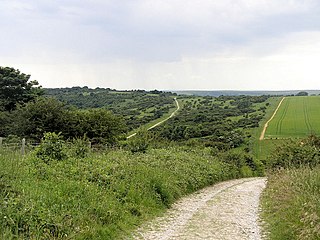
Calcareous grassland is an ecosystem associated with thin basic soil, such as that on chalk and limestone downland. Plants on calcareous grassland are typically short and hardy, and include grasses and herbs such as clover. Calcareous grassland is an important habitat for insects, particularly butterflies, and is kept at a plagioclimax by grazing animals, usually sheep and sometimes cattle. Rabbits used to play a part but due to the onset of myxomatosis their numbers decreased so dramatically that they no longer have much of a grazing effect.

The North Downs are a ridge of chalk hills in south east England that stretch from Farnham in Surrey to the White Cliffs of Dover in Kent. Westerham Heights, at the northern edge of the North Downs, near Bromley, South London, is the highest point in London at an elevation of 245 m (804 ft). The North Downs lie within two Areas of Outstanding Natural Beauty (AONBs), the Surrey Hills and the Kent Downs. The North Downs Way National Trail runs along the North Downs from Farnham to Dover.

A heath is a shrubland habitat found mainly on free-draining infertile, acidic soils and is characterised by open, low-growing woody vegetation. Moorland is generally related to high-ground heaths with—especially in Great Britain—a cooler and damper climate.
A calcicole, calciphyte or calciphile is a plant that thrives in lime rich soil. The word is derived from the Latin 'to dwell on chalk'. Under acidic conditions, aluminium becomes more soluble and phosphate less. As a consequence, calcicoles grown on acidic soils often develop the symptoms of aluminium toxicity, i.e. necrosis, and phosphate deficiency, i.e. anthocyanosis and stunting.
This article gives an overview of the calcicolous grassland communities in the British National Vegetation Classification system.

St Boniface Down is a chalk down on the Isle of Wight, England. It is located close to the town of Ventnor, in the southeast of the Island, and rises to 241 metres (791 ft), the Island's highest point, 1 kilometre (0.6 mi) north of the town. There is reputed to be a wishing well on its southern slope, which requires the wisher to climb up from the south without looking back. In 1545 a French invasion force attempted this against a force of the Isle of Wight Militia commanded by Sir John Fyssher- which allegedly included several women archers- and were routed. In 1940 the radar station was bombed by Ju 87 Stuka dive bombers, which is reconstructed in the film "The Battle of Britain". The top is surmounted by a round barrow.

Scotstown Moor is in the north of Aberdeen, Scotland.
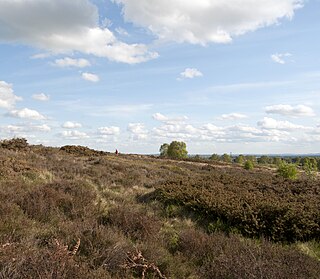
Gentleshaw Common is an area of common land situated in Gentleshaw on the northern side of Burntwood in Staffordshire, England. The area is a Site of Special Scientific Interest as it is an area of globally rare lowland heathland. The common plays host to a series of fun public events throughout the year, including scrub bashing and countryside walks.
Base-richness in ecology is the level in water or soil of chemical bases, such as calcium or magnesium ions. Many organisms are restricted to base-rich environments. Chemical bases are alkalis, and so base-rich environments are neutral or alkaline. Because base-poor environments have few bases, they are dominated by environmental acids and so are acidic. However, the relationship between base-richness and acidity is not a rigid one – changes in the levels of acids may significantly change acidity without affecting base-richness.
Lowland Heath is a Biodiversity Action Plan habitat as it is a type of ancient wild landscape. Natural England's Environmental Stewardship scheme describes lowland heath as containing dry heath, wet heath and valley mire communities, usually below 250 metres in altitude, on acidic soils and shallow peat, typically comprising heathers, gorses, fine grasses, wild flowers and lichens in a complex mosaic. Heathers and other dwarf shrubs usually account for at least 25% of the ground cover. By contrast, upland heath, which is above 300 metres in altitude, is called Moorland, Dartmoor being an example.
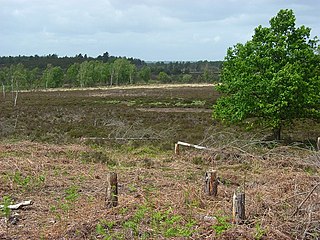
Woolmer Forest is a royal hunting forest. It lies within the western Weald in the South Downs National Park, straddling the border between east Hampshire and West Sussex. Covering an area of some 1,293.9 hectares, it is both a Special Area of Conservation and a Site of Special Scientific Interest. Historically a largely treeless heathland on sterile sandy soils, the forest was traditionally managed, like other royal forests, as "wood pasture" in which deer would be kept for hunting by the aristocracy for sport and for venison, and where commoners were permitted to graze their livestock. The forest today consists of both dry and humid lowland heath. It contains the largest and most diverse area of lowland heathland habitats outside the New Forest and is considered to be the most important area of heathland in the Weald of southern England; it is the only site in England known to support all twelve known native species of reptiles and amphibians, and it supports a nationally important heathland flora with associated birds and invertebrate fauna.

Allerthorpe Common is a Site of Special Scientific Interest (SSSI) and nature reserve in the East Riding of Yorkshire, England. It is located close to the town of Pocklington. The site, which was designated a SSSI in 1951, lies on river and lake sands, which were deposited during the last glacial period 12-10,000 years ago. The soils are acidic and a variety of habitats, including wet and dry heath, mire, grassland and woodland have formed. The drier areas are dominated by heather interspersed with cross-leaved heath and purple moor grass. In the wetter areas purple moor grass forms dense tussocks. Common cottongrass and marsh cinquefoil occur in the wet mire conditions.
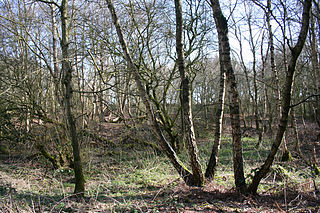
Sound Heath, also known as Sound Common, is an area of common land in Sound, near Nantwich in Cheshire, England, which includes heathland, grassland, scrub, woodland and wetland habitats. The majority of the area is designated a Site of Special Scientific Interest and a Local Nature Reserve.

Waldridge Fell is a Site of Special Scientific Interest located immediately south-west of Chester-le-Street in the northern part of County Durham, England. It is one of the largest areas of lowland heath in County Durham and contains the only lowland valley-mire in the county. The fell is home to a number of plants and insects that are scarce to rare elsewhere in the county.
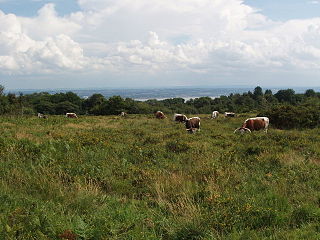
Poor's Allotment is a 28.57-hectare (70.6-acre) biological Site of Special Scientific Interest in Gloucestershire, notified in 1954. The site is listed in the 'Forest of Dean Local Plan Review' as a Key Wildlife Site (KWS).

Hartland Moor is a Site of Special Scientific Interest (SSSI) on the south side of Poole Harbour near the town of Wareham in Dorset, England. It consists of lowland heathland.

Allolee to Walltown is the name given to a Site of Special Scientific Interest (SSSI) in Northumberland, England. The site, which follows the path of a section of Hadrian's Wall, is notable for an unusually wide range of grassland types growing on thin soil above the Whin Sill, a rock formation peculiar to the Northern Pennines.

Arcot Hall Grasslands and Ponds is the name given to a Site of Special Scientific Interest (SSSI) near Cramlington in Northumberland, England, notable as the largest lowland species-rich grassland in North East England. The site is composed of grassland, heath, ponds, and associated damp habitats now rare in Northumberland.














